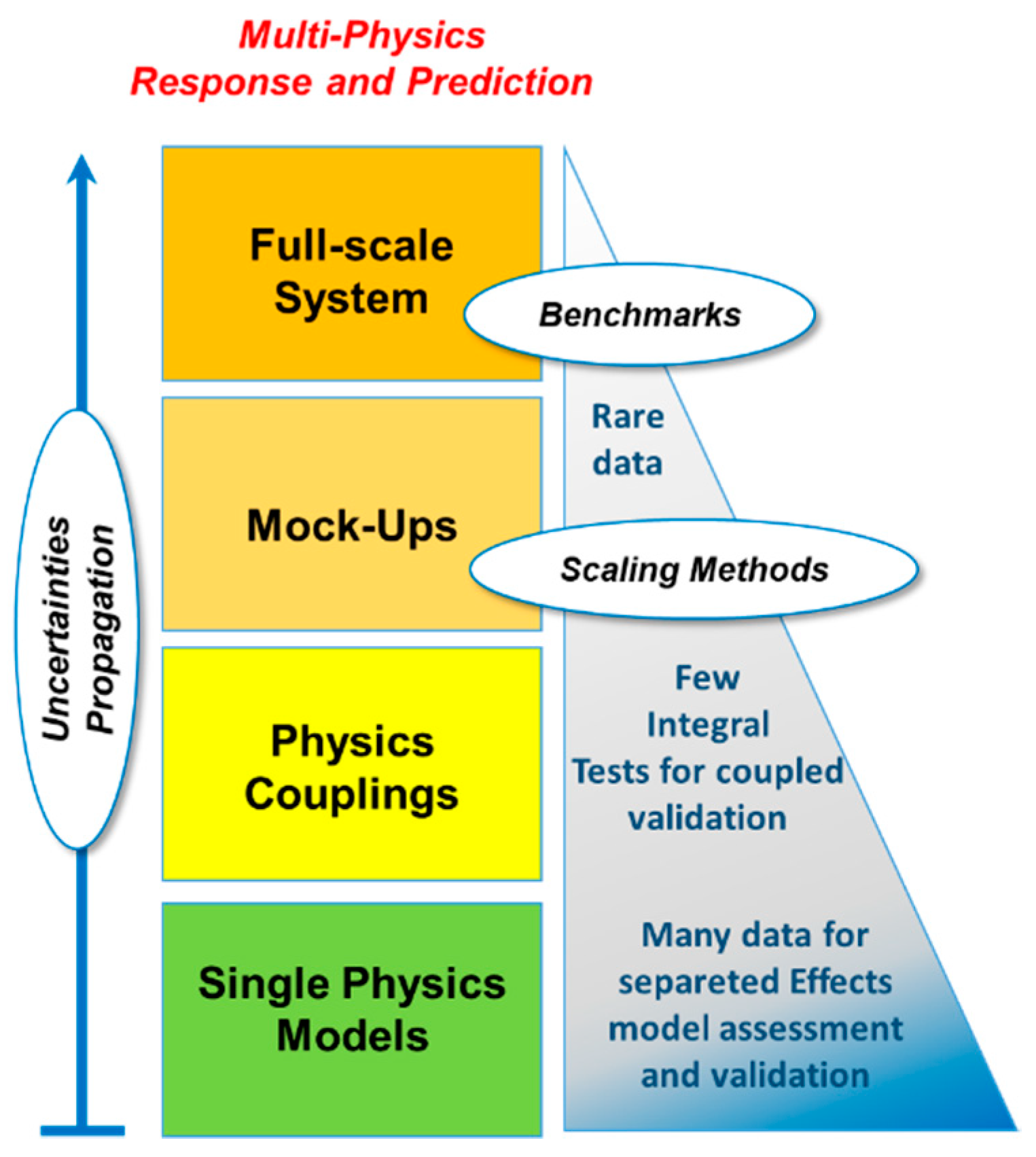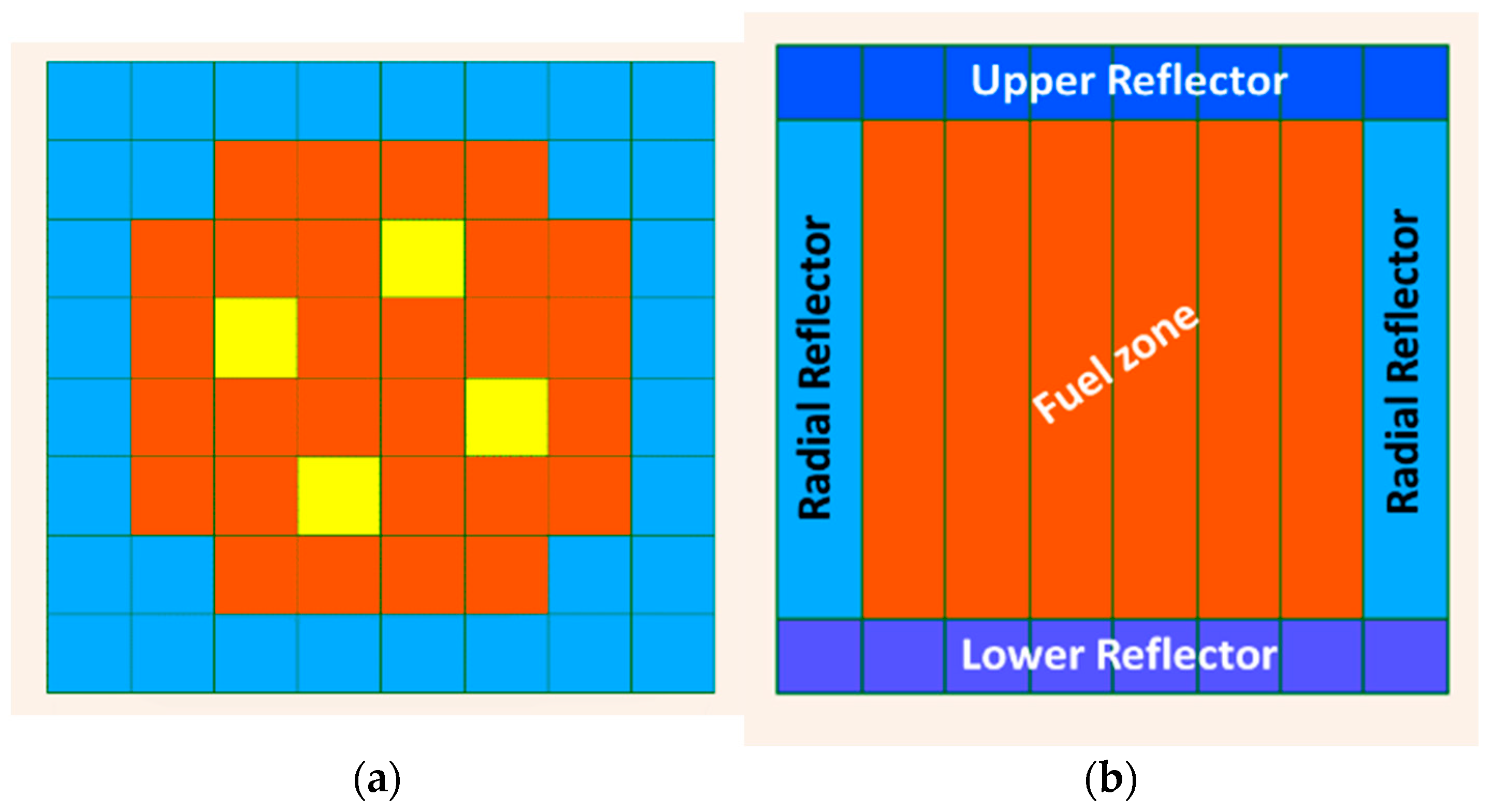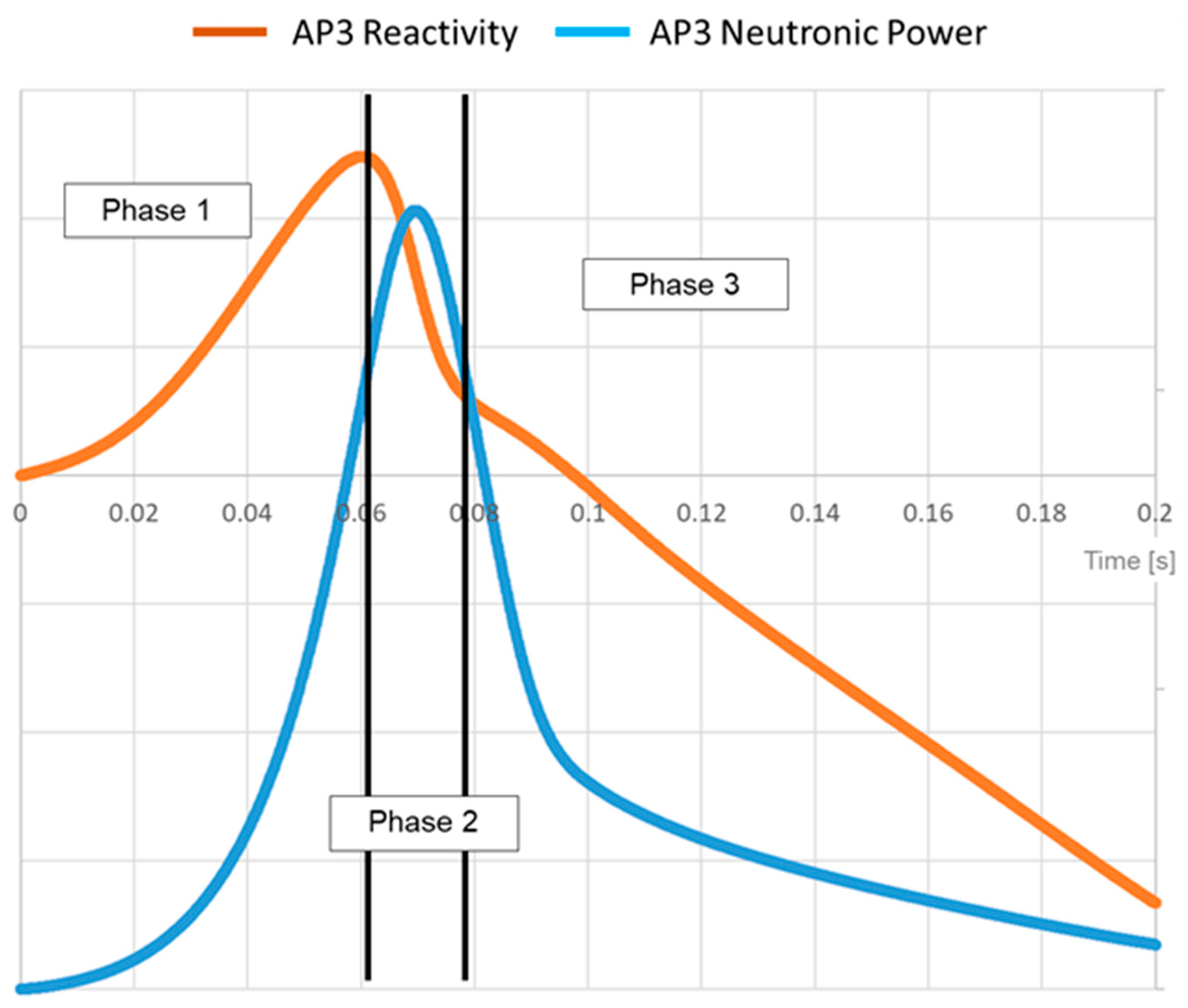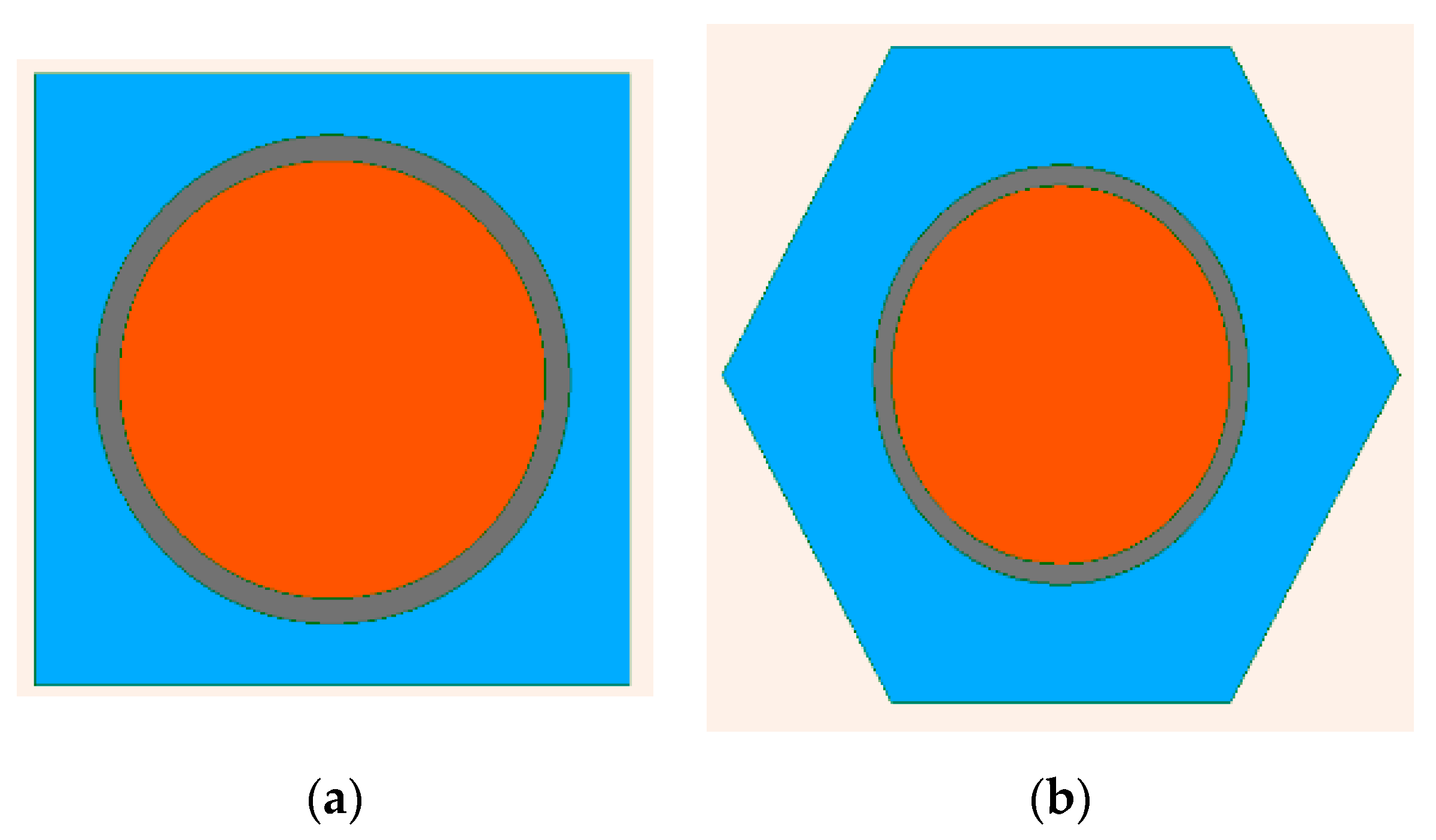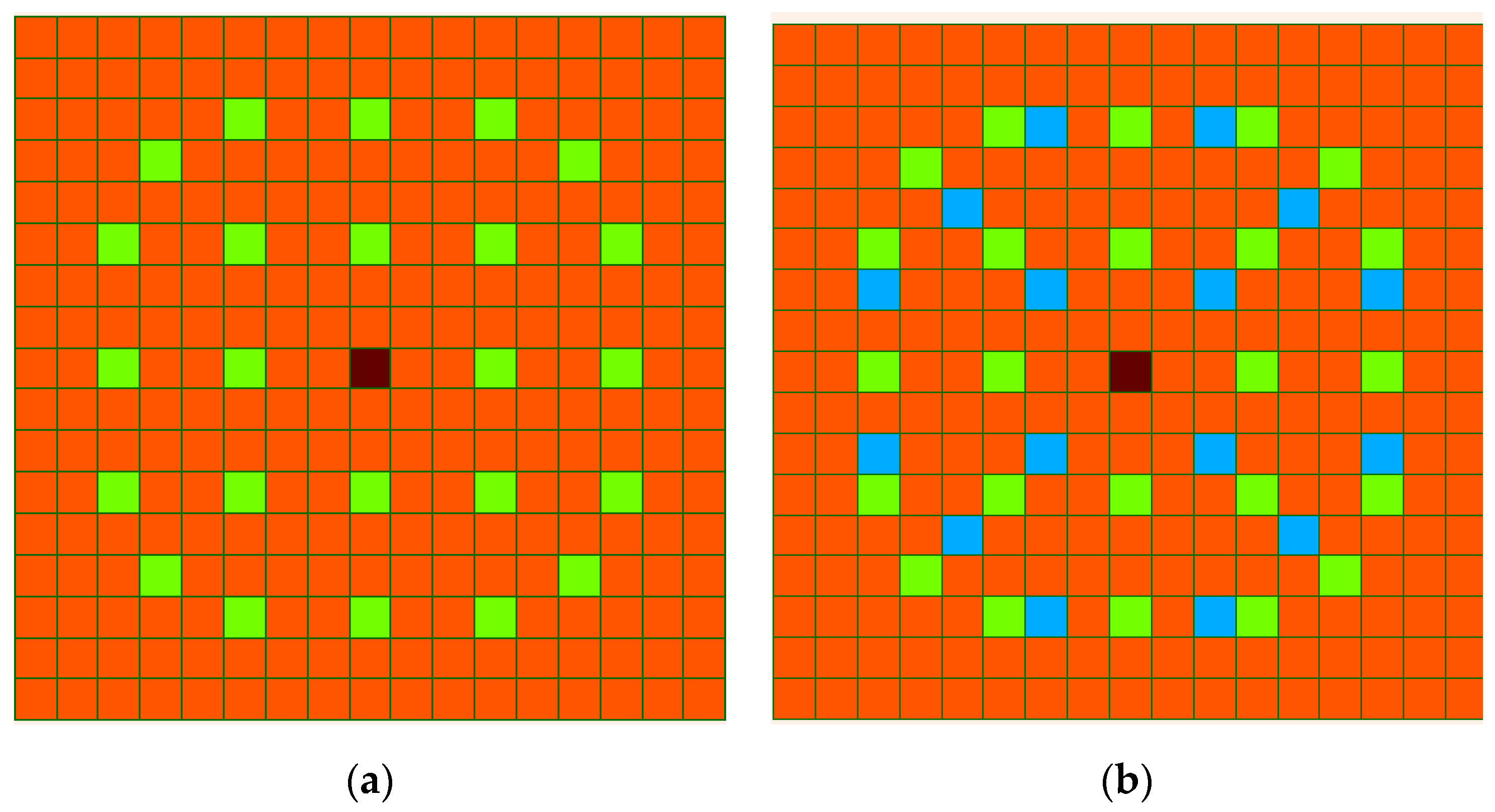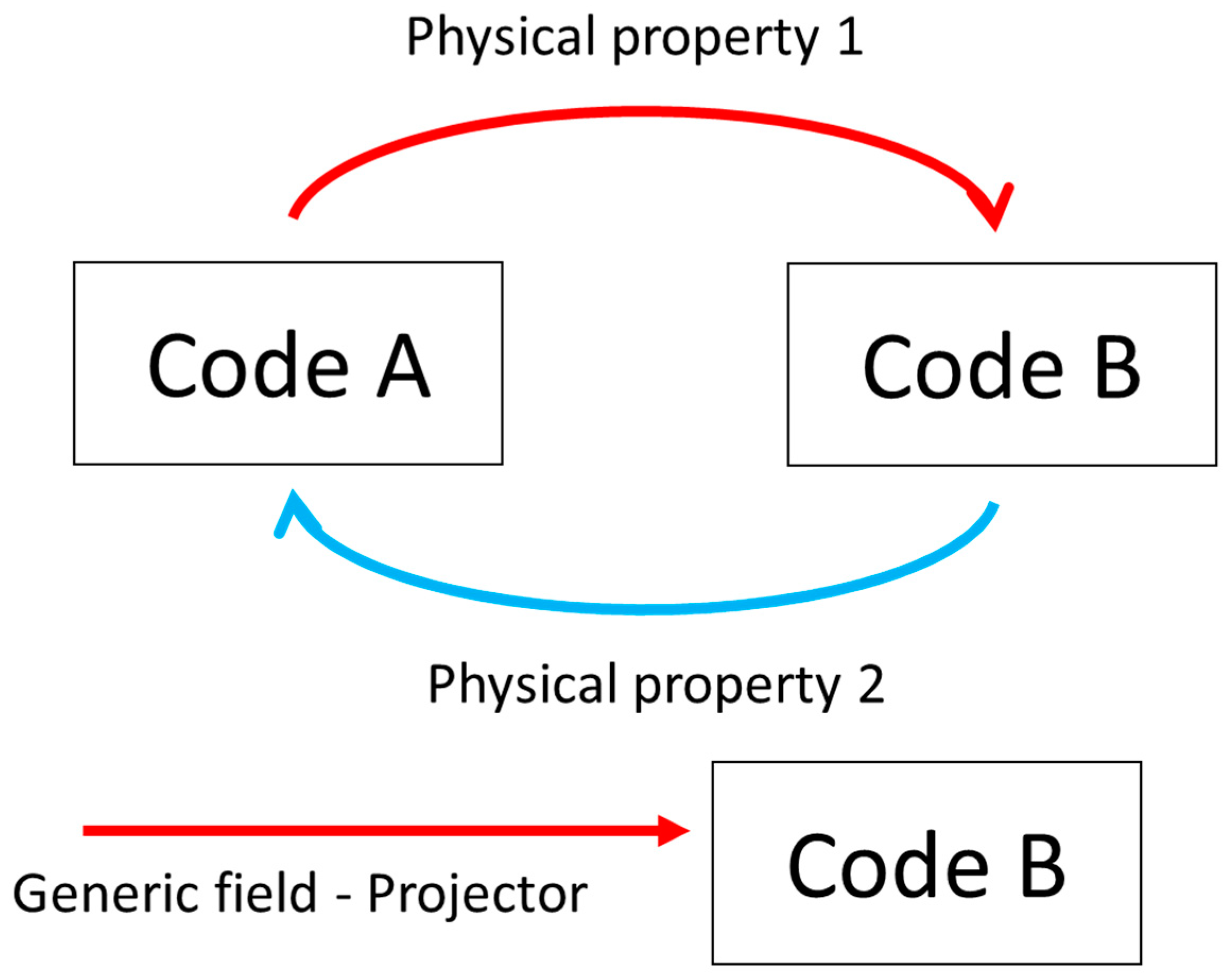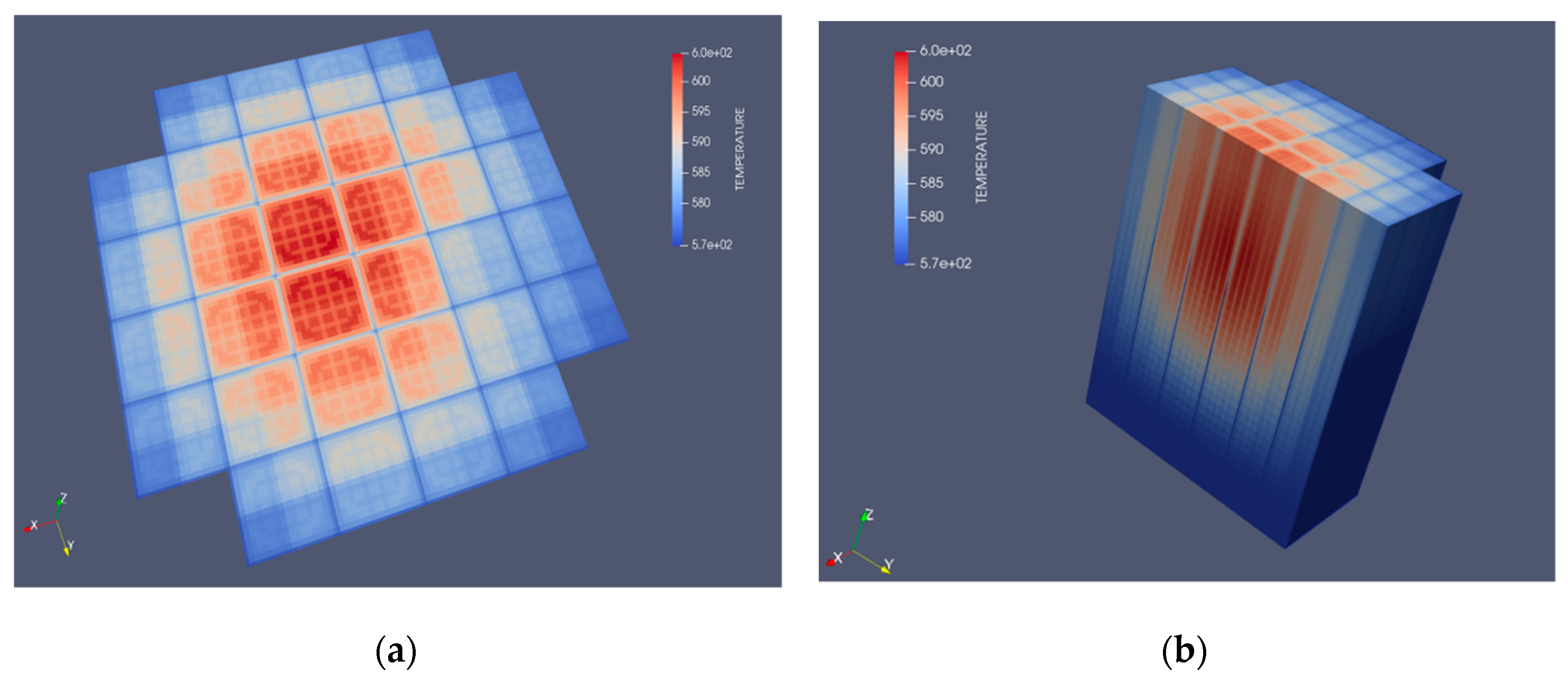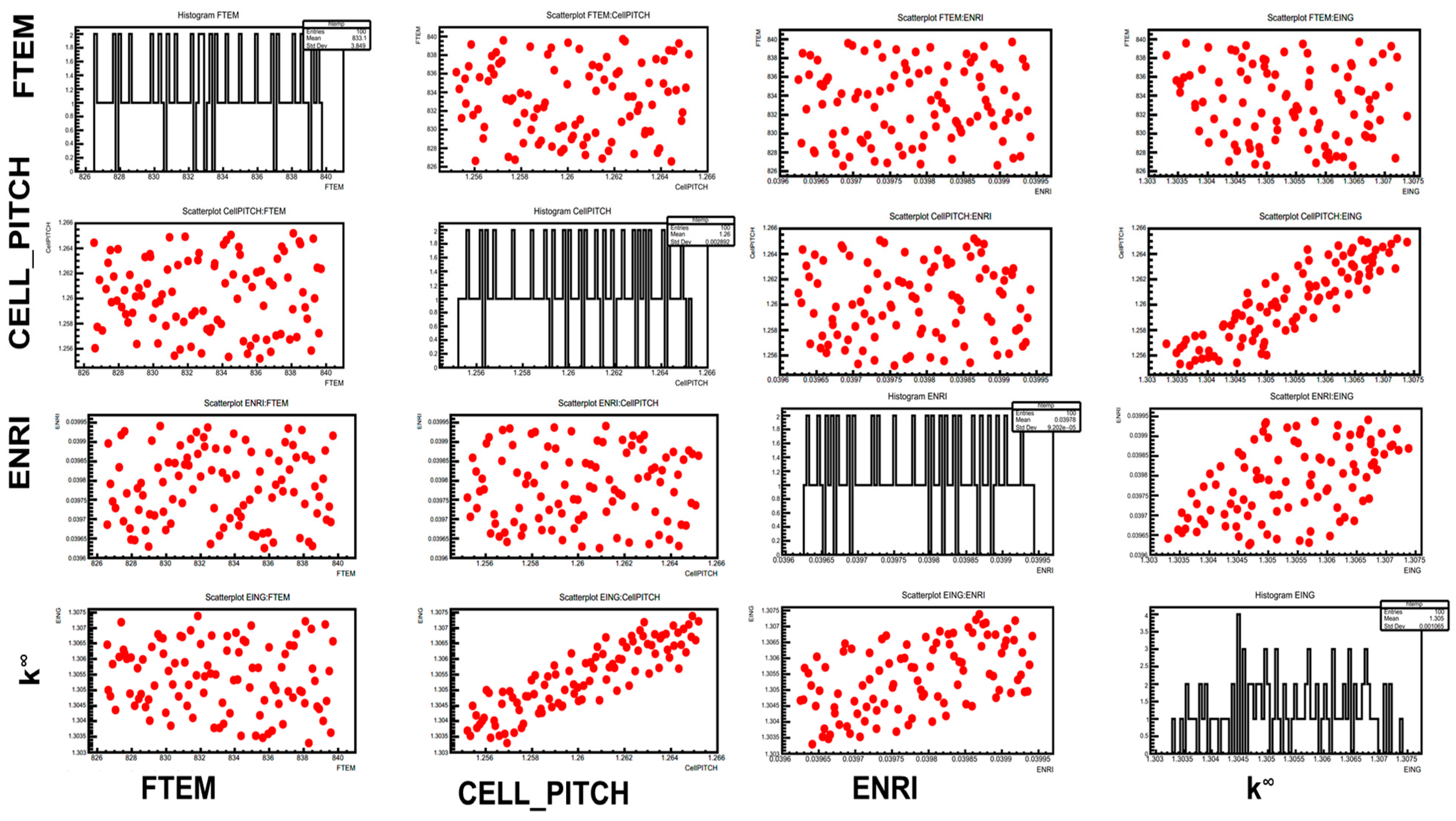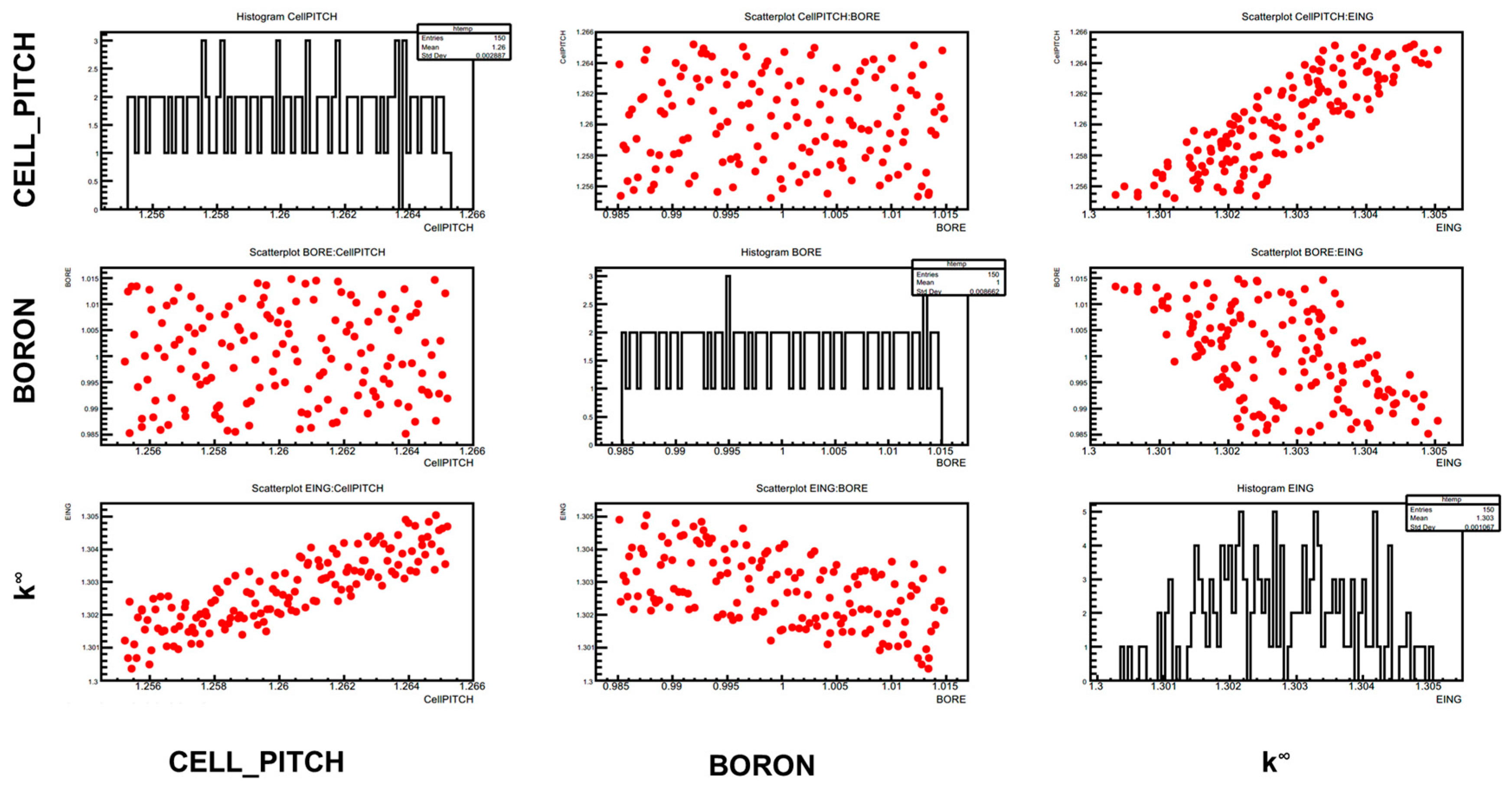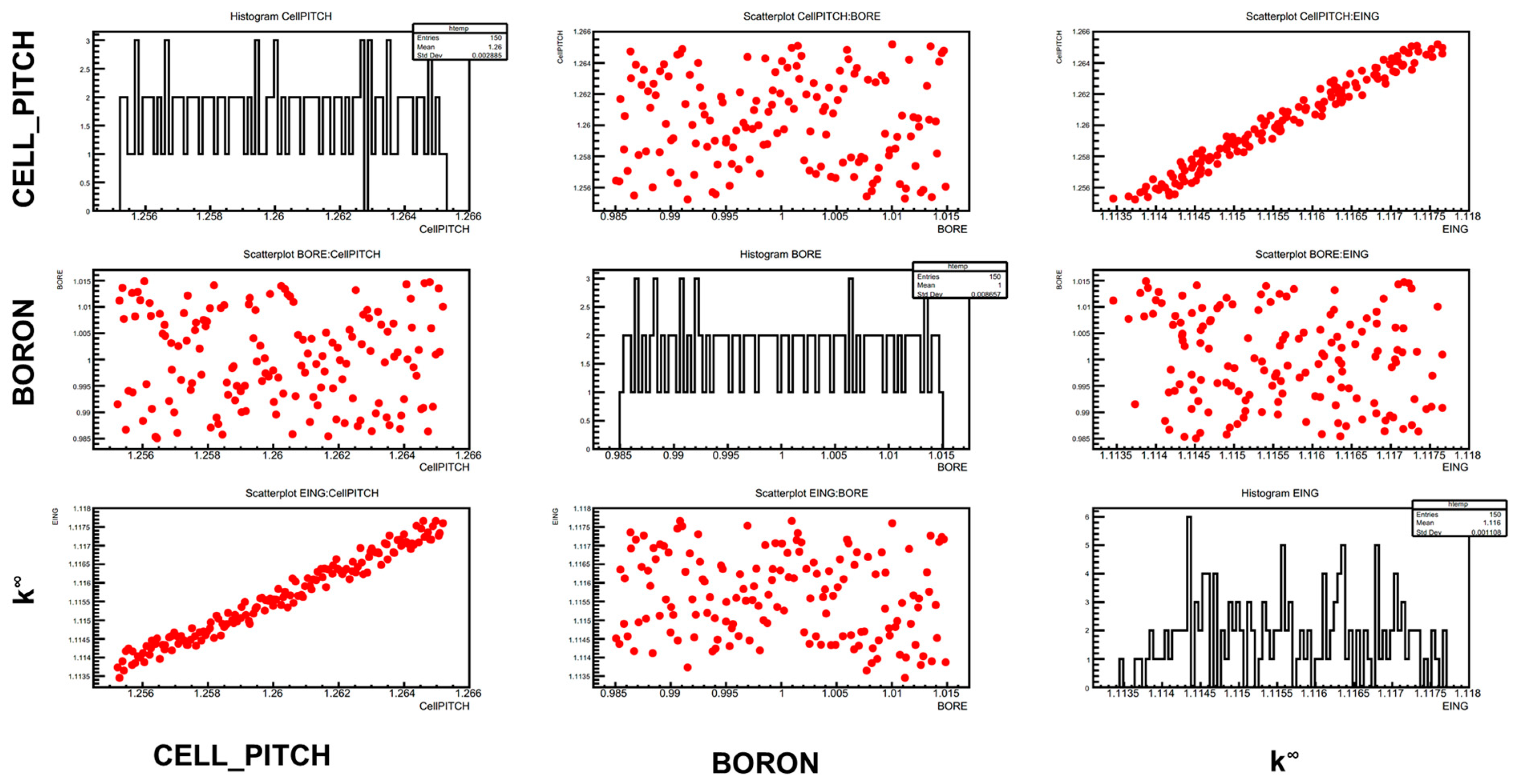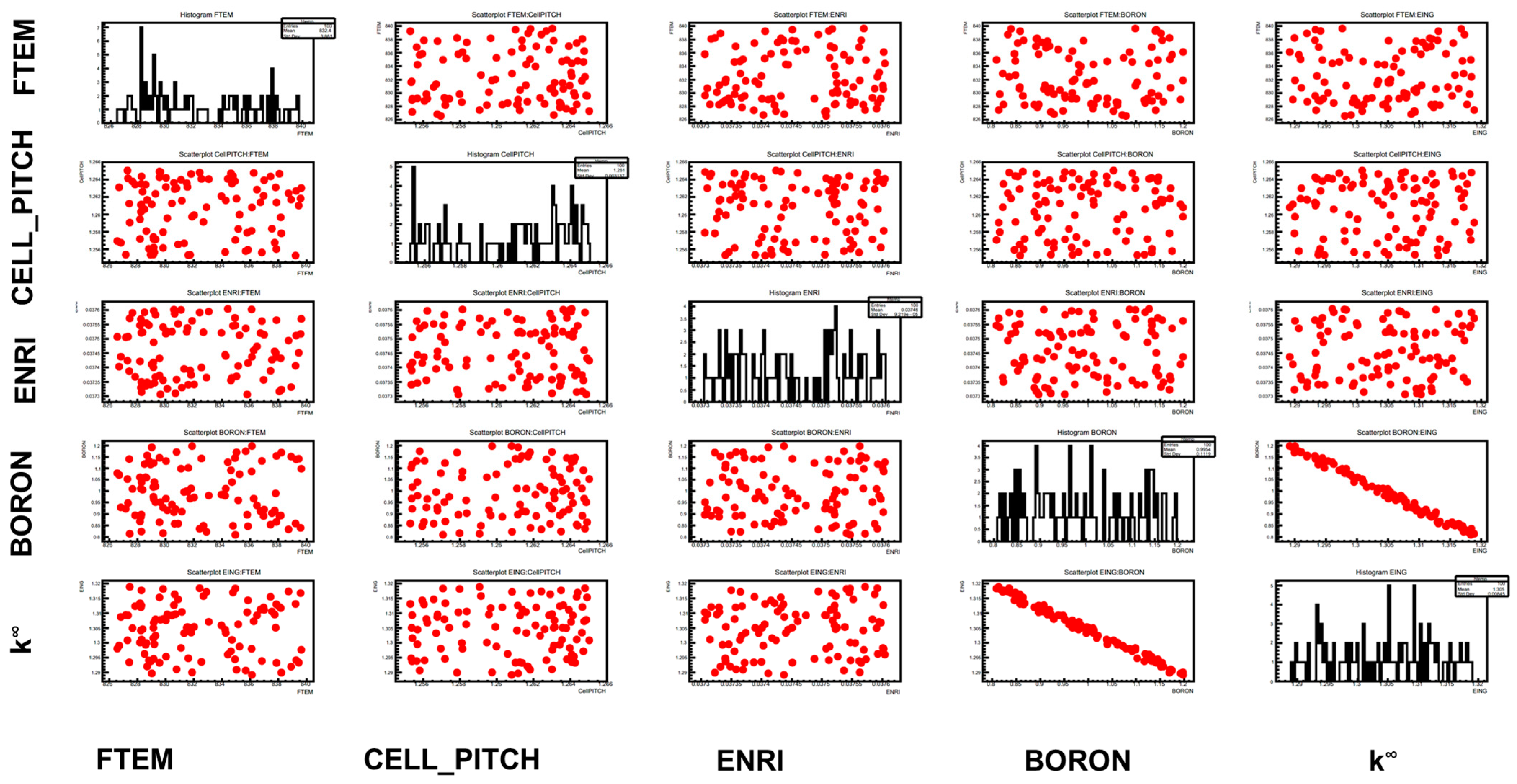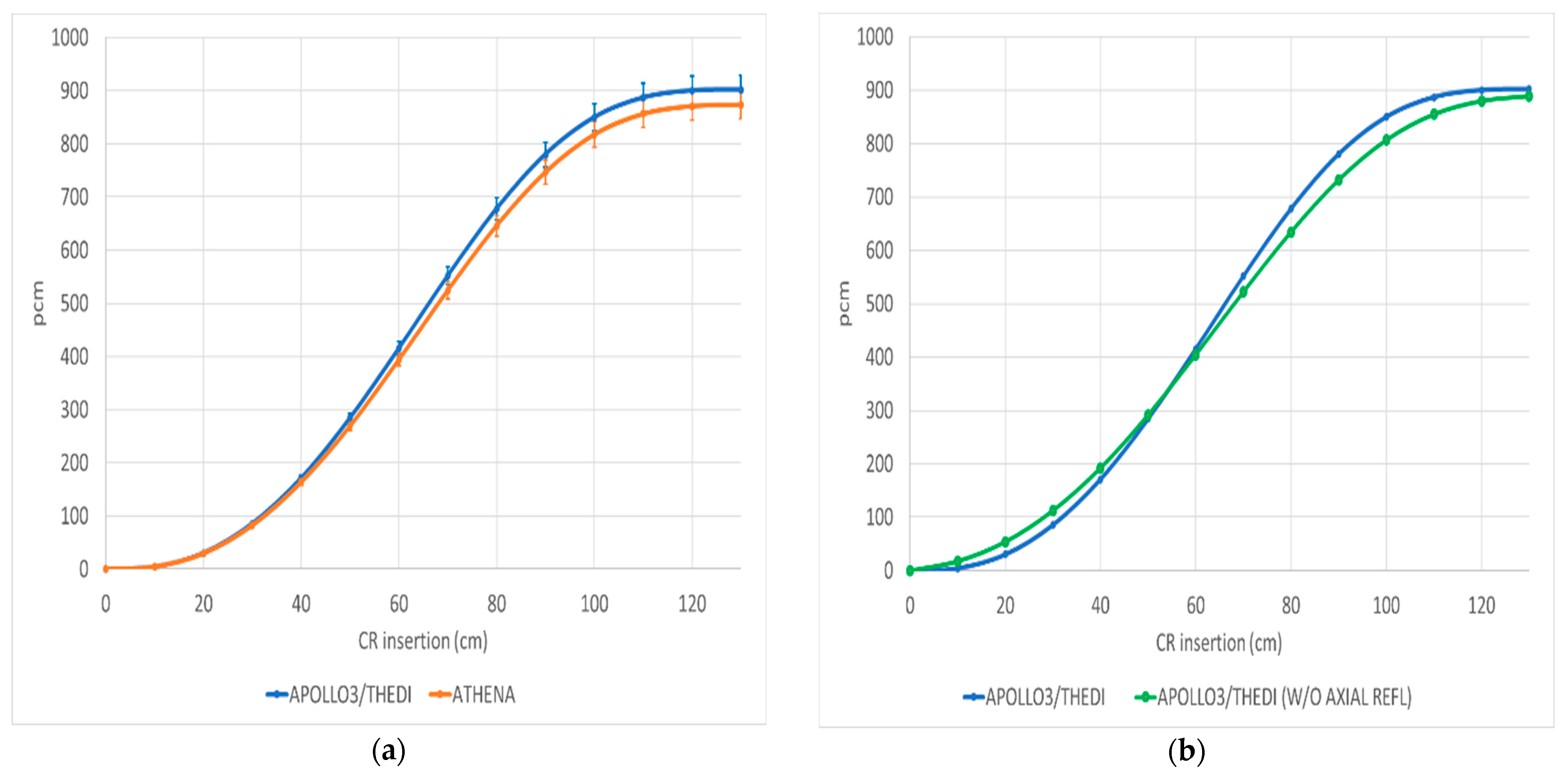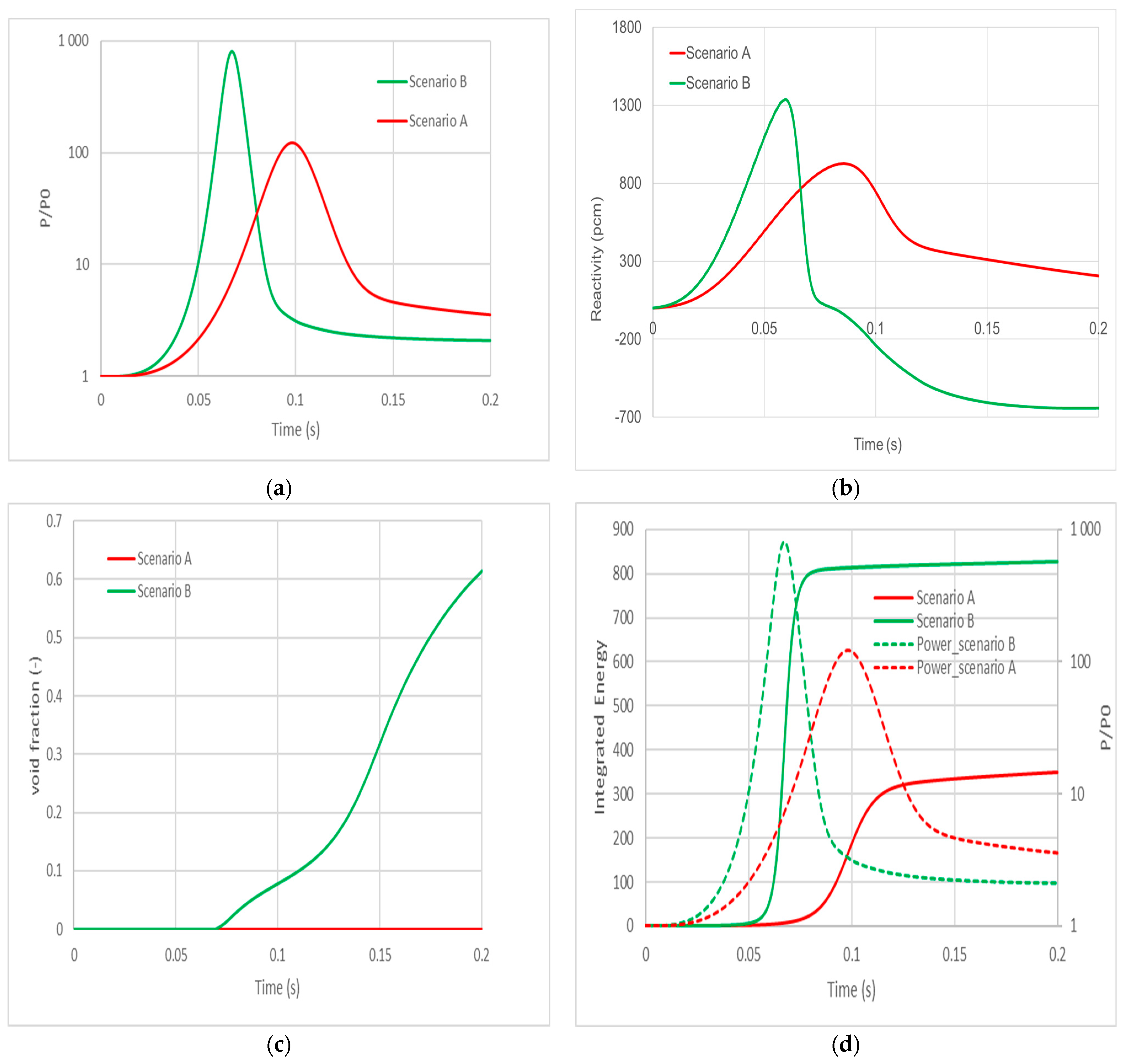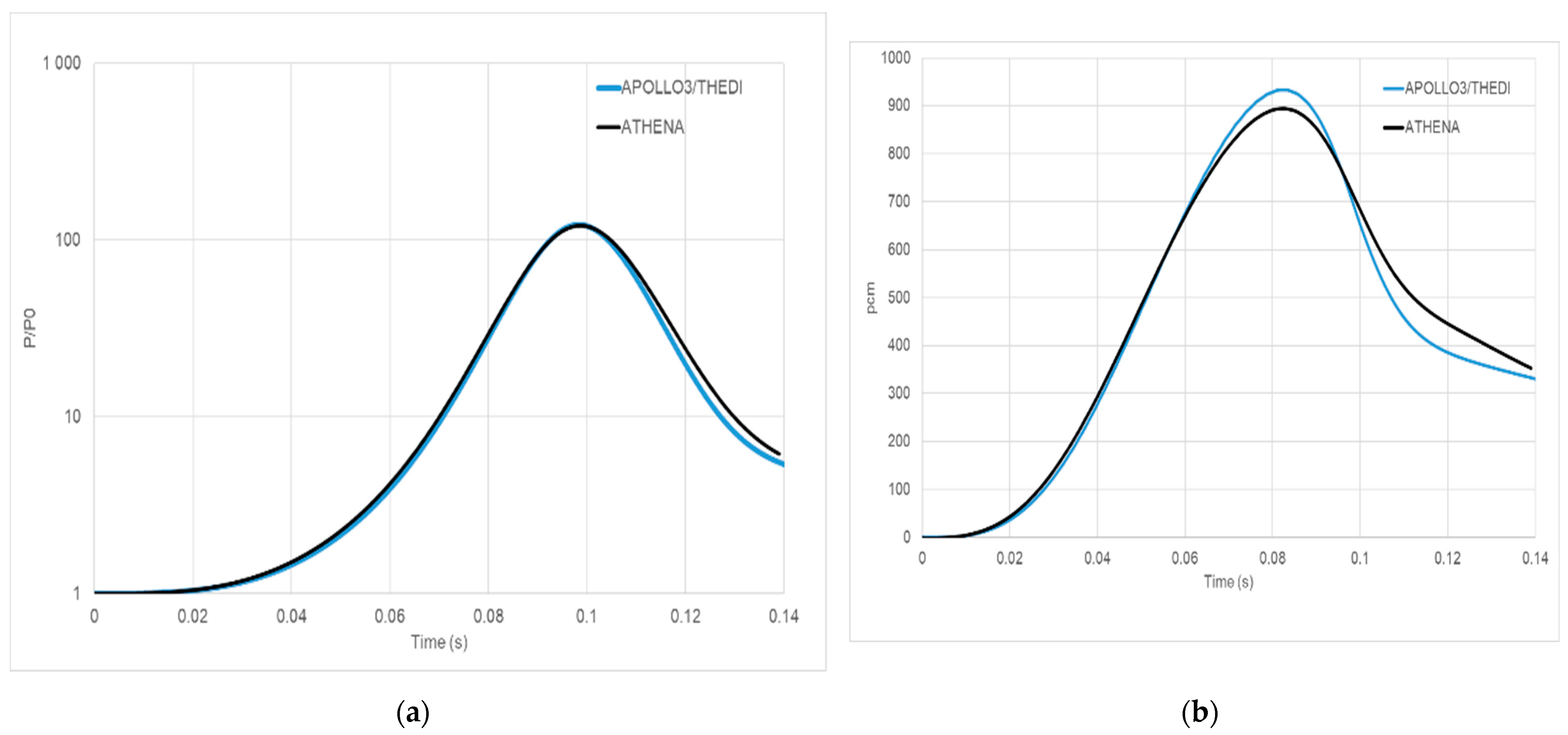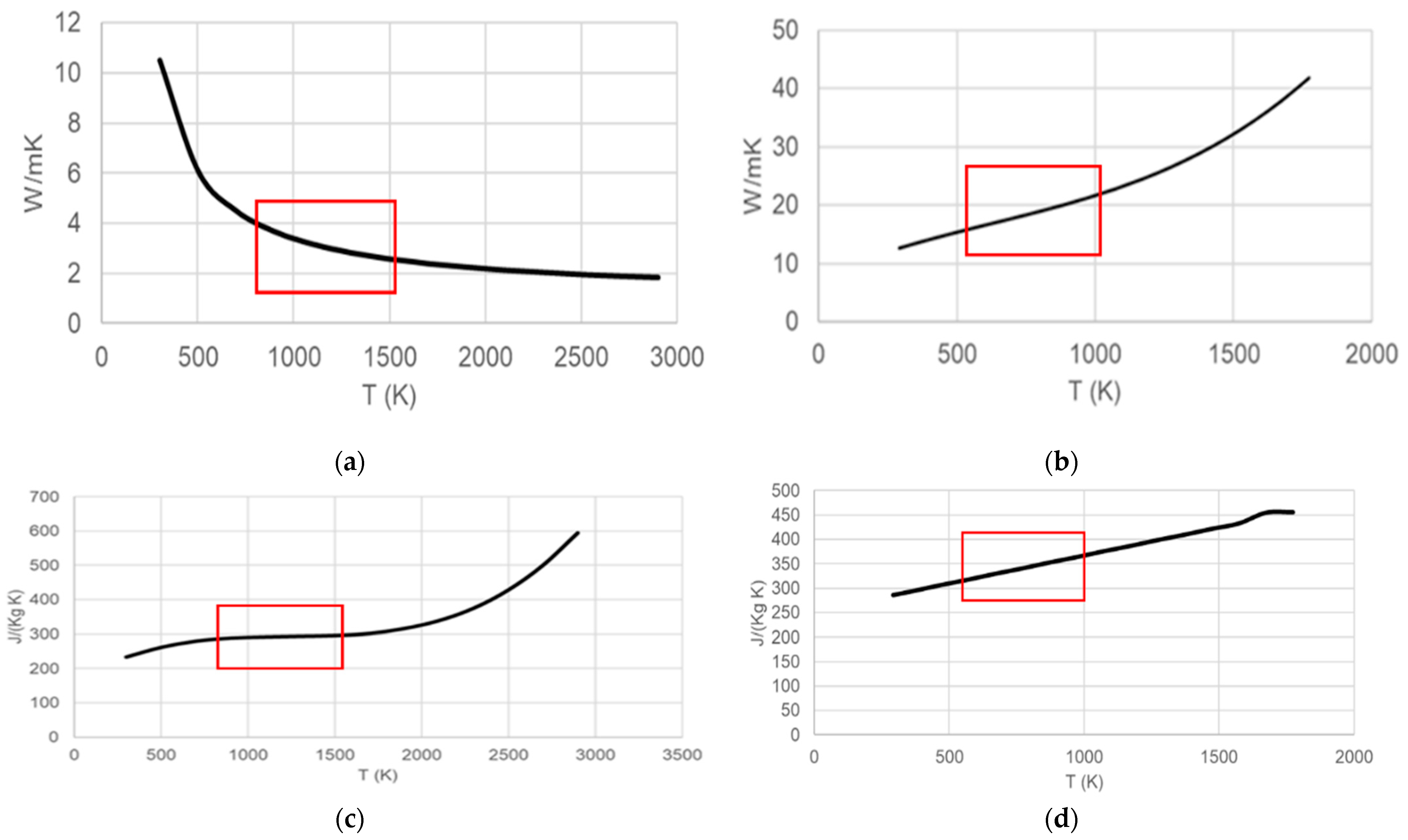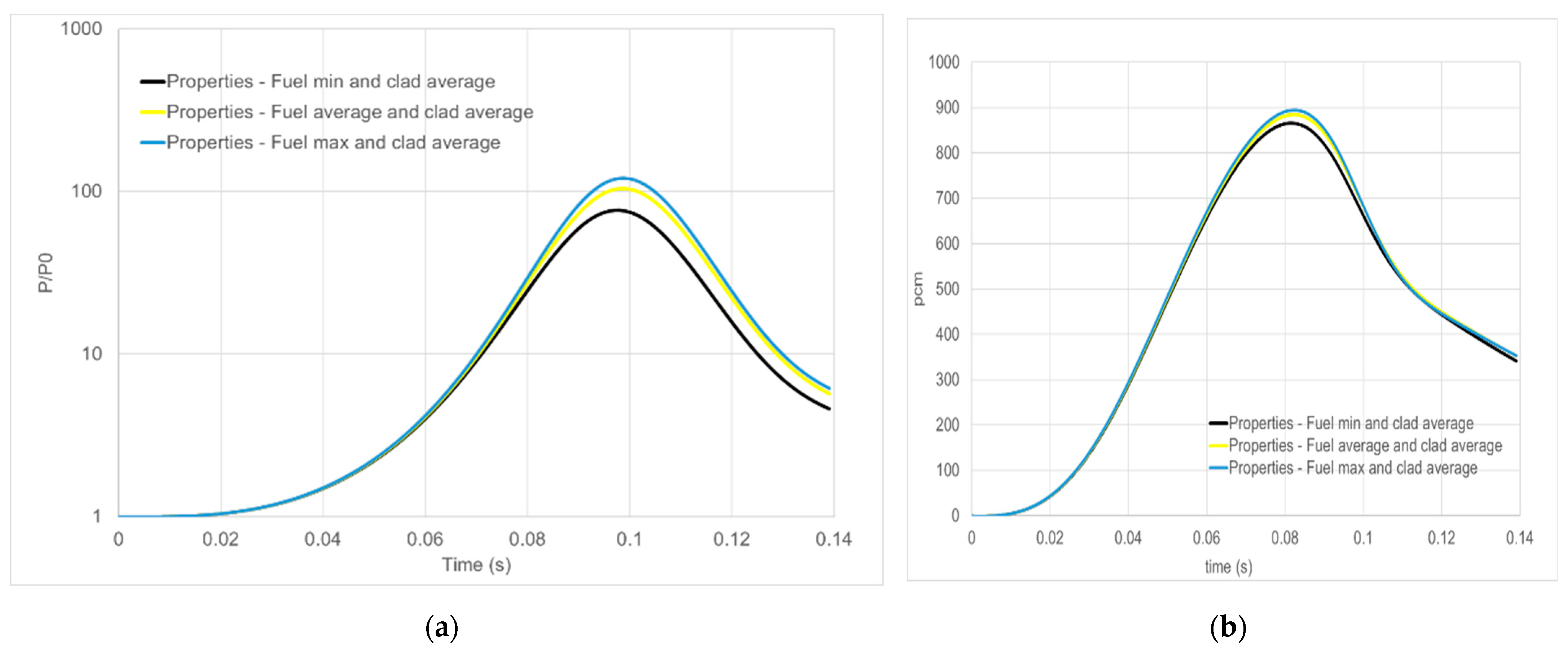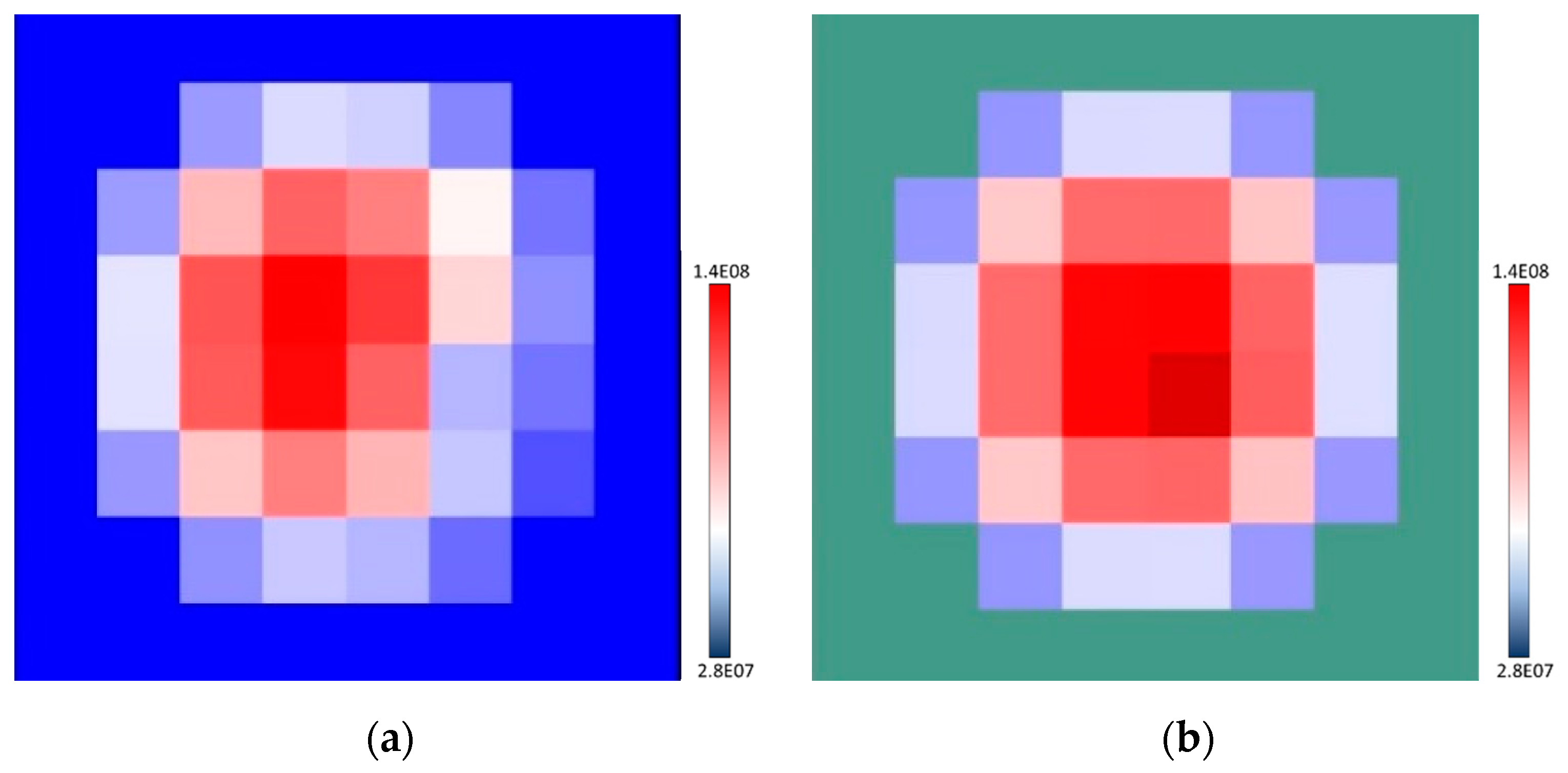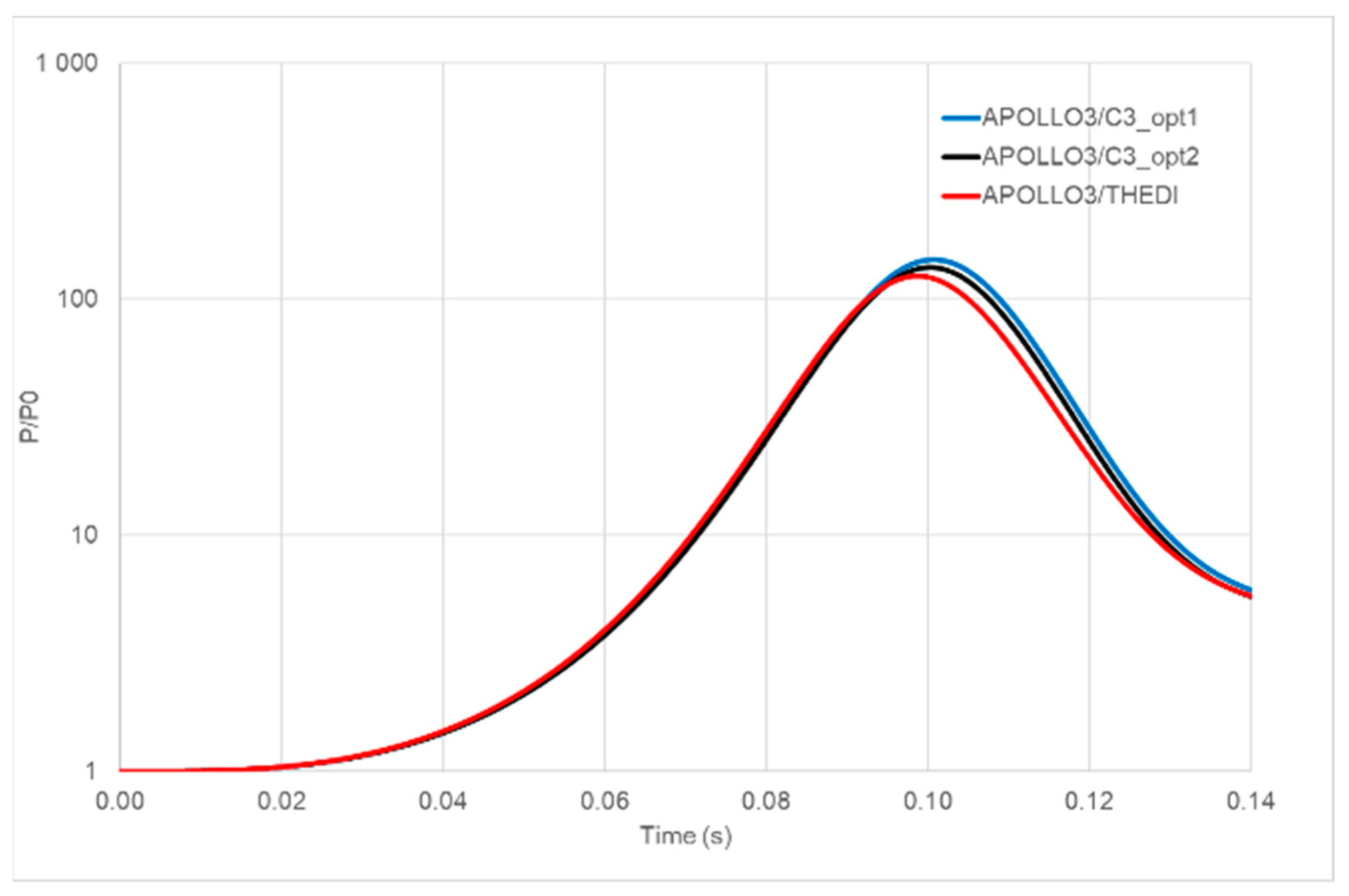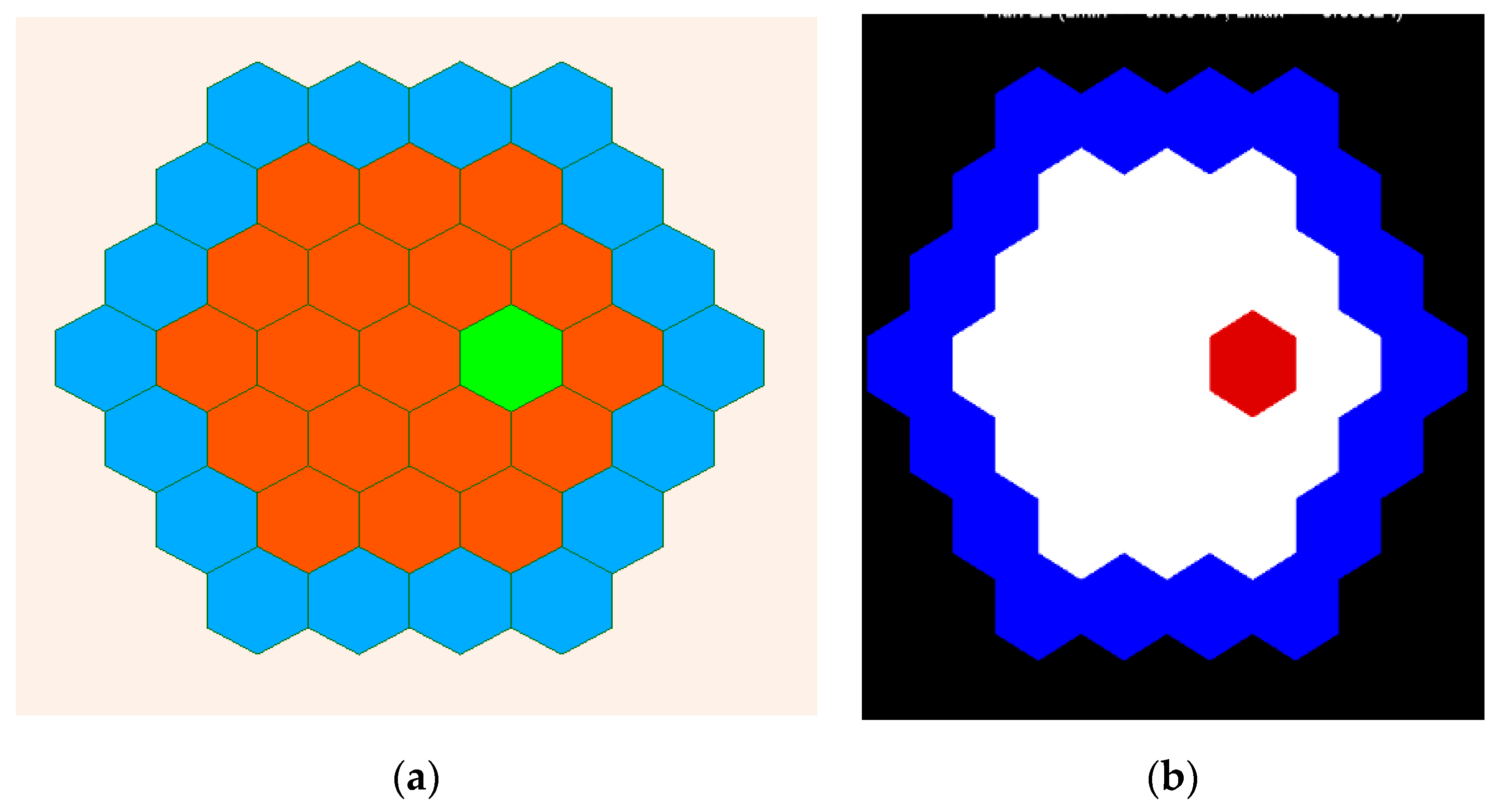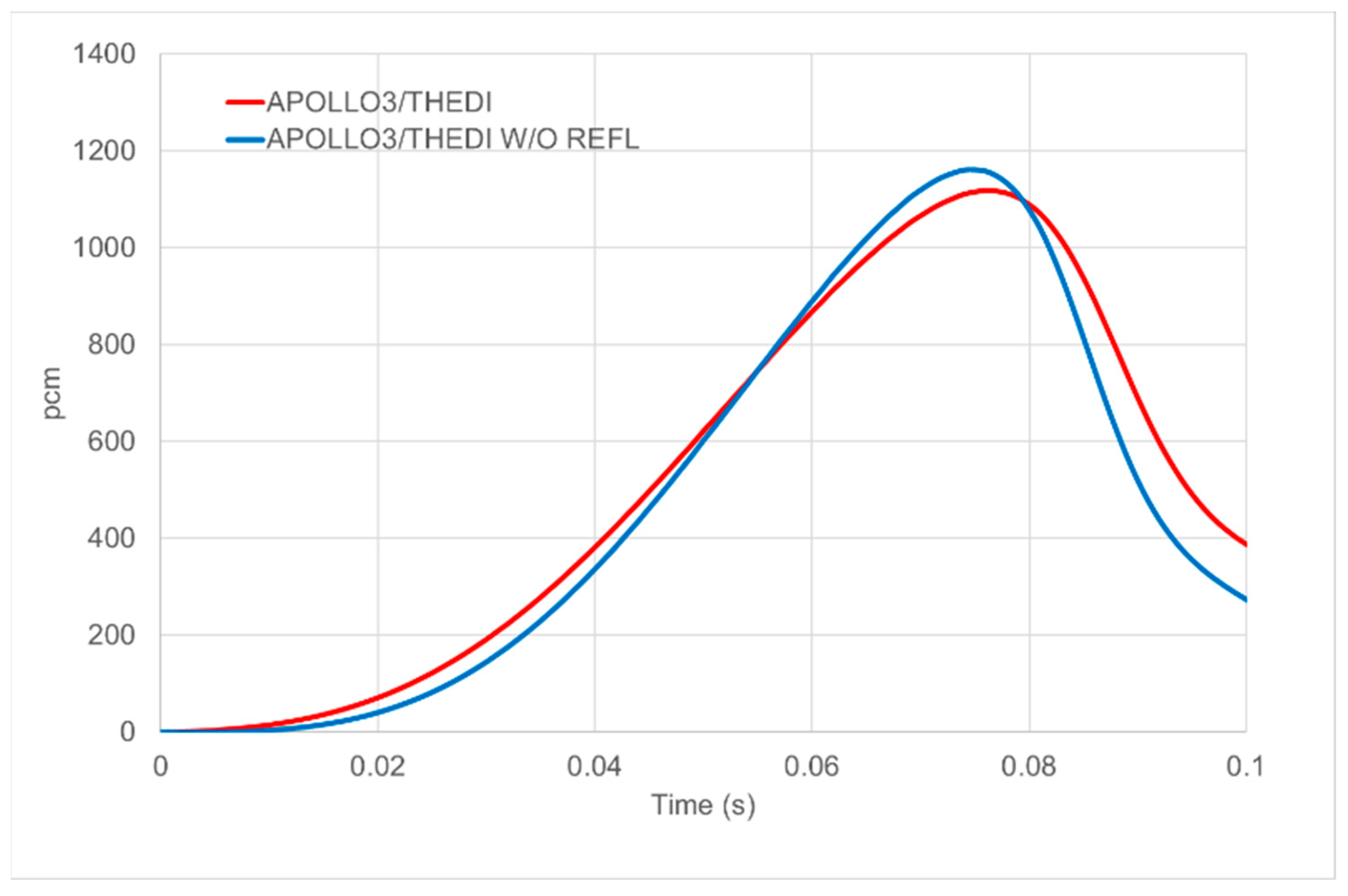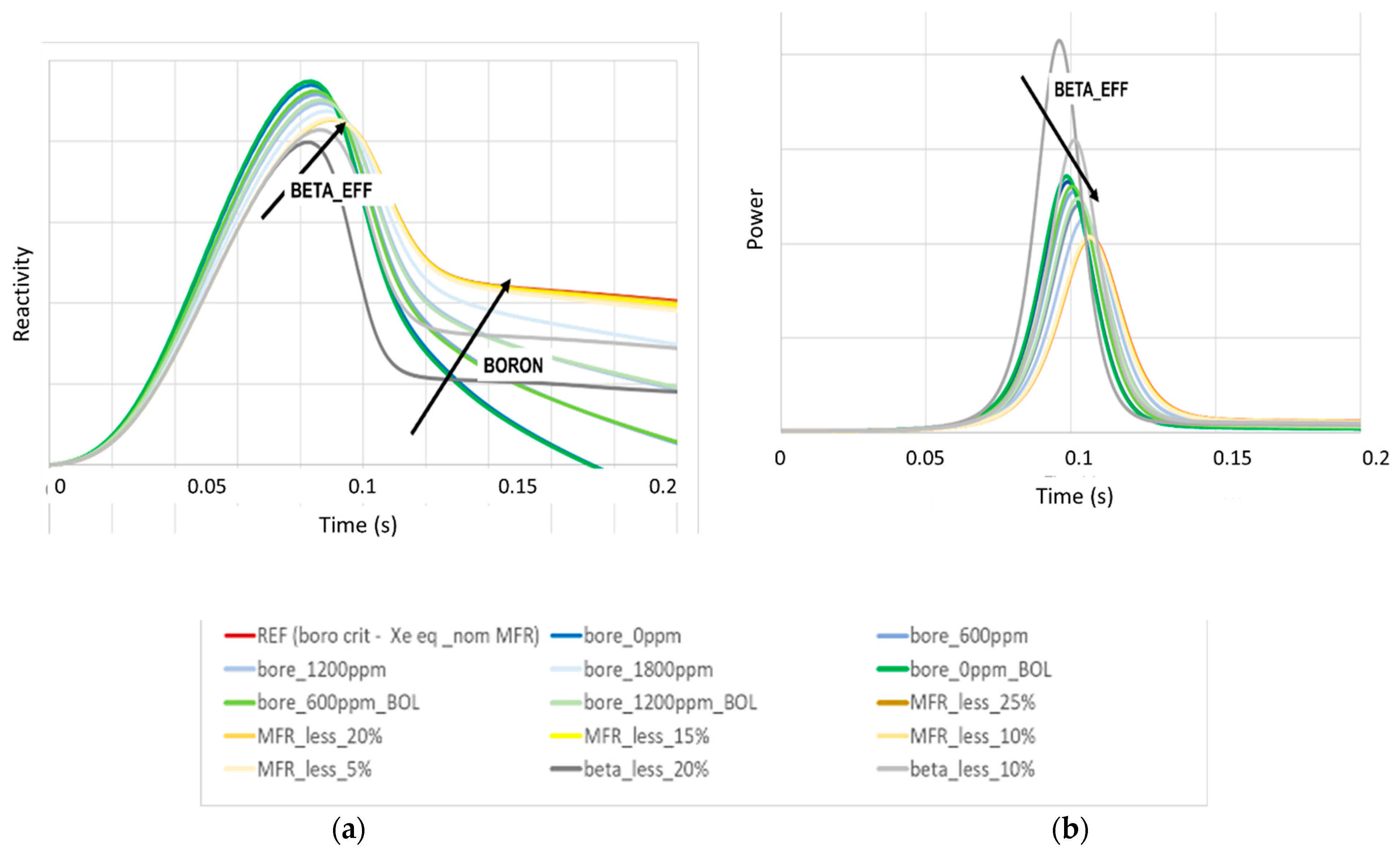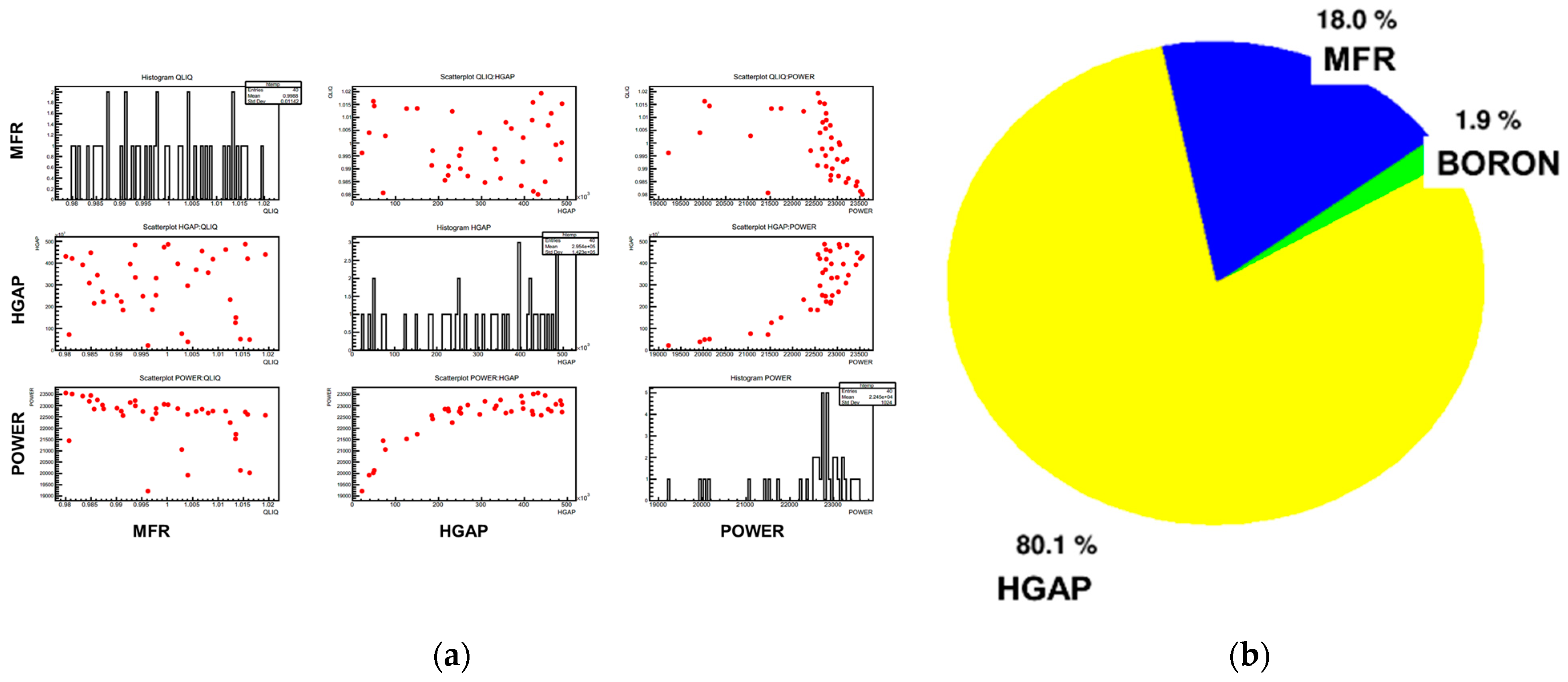In the following parts of the paper, the configurations and the codes are used described.
2.1. Lattice and Core Test Cases Description
Simplified core models have been defined within the CAMIVVER Project (Ref. [
1]) for investigating the advantages of 3D neutronics/thermal-hydraulics-coupled calculations while keeping the computational time reasonable.
The size was chosen for favorizing the deployment of an advanced coupling based on APOLLO3
®/CATHARE3 (proof of concept under development during the CAMIVVER Project) and the comparison with High-Fidelity Monte Carlo-based solutions coupled with subchannel codes [
5]. The choice of reduced size cases has also been made to open the discussion on code capabilities for treating different core sizes and innovative small size reactors as the Small Modular Reactor (SMR) concepts as indicated in other Projects [
17].
32 Fuel Assembly PWR Minicore Case
The first configuration analyzed is a 32 Fuel Assemblies (FA) PWR minicore case as described in
Figure 2. The configuration, based initially on Ref. [
18], has been improved in the framework of the CAMIVVER Project for allowing benchmarks among different codes [
19,
20].
Figure 2 for a total of thirty-two FAs. The core dimensions are shown in
Table 1. In order to simulate several transient scenarios, four control rods (CRs) are located in the central part of the core (see
Figure 2). FAs and CRs details are indicated in
Table 2 and
Table 3. The configuration is completed by simplified radial and axial reflector models. The reflectors are modeled as 1D-slab (indicated in
Figure 3 as “L
i rad” for the radial reflector, “L
i low” for the lower reflector, and “L
i up” for the upper reflectors), and the composition of each slab is shown in
Table 4. More details are available in Refs. [
19,
20].
Hexagonal Minicore Cases
Hexagonal geometry small core benchmarks typical of VVER type reactor have been proposed within the CAMIVVER Project [
19]. The benchmark selected by the project is a small heterogeneous core containing seven hexagonal FA of different types based on the Khmelnytsky-2 or on the Kozloduy-6 specifications [
19,
20,
21,
22,
23].
In the present paper, a slightly different configuration has been chosen to test the capability of the sensitivity analysis tool for treating hexagonal geometry (see
Figure 4).
The core used is a 19 hexagonal FA core case with a homogeneous fuel loading, as indicated in
Figure 4. Three CRs are in the central part of the core (see
Figure 4). The configuration is completed by simplified radial and axial reflectors in agreement with the 32 FA PWR minicore case.
This first investigation has been proposed by Framatome to get confident with hexagonal geometry configurations and to test selected code capabilities on hexagonal cases. These preliminary tests support the analyses foreseen during the benchmark exercise planned in the CAMIVVER project [
19].
Transients Cases
In the CAMIVVER project, different reactivity insertion accident (RIA) transients have been defined for the core cases selected: (1) a rod ejection event and (2) a sudden change of the thermal-hydraulics boundary conditions [
19].
Those transients have been chosen for their interest in challenging innovative 3D-multiphysics solutions.
These transients, characterized by different system time-response and feedbacks, are suitable cases to show the relationships among the three types of physics involved in the normal and transient operation of a nuclear power plant: neutronics, thermal-hydraulics, and thermo-mechanics. The fine mesh deeply coupled resolution of the three physics remains up to now, not possible for industrial applications (calculation time and memory imprinting are too important, etc.), and decoupled approaches have been developed in order to speed up calculations and to associate reasonable acceptance to calculated design limits. The decoupling strategy has introduced simplifications to treating those physics depending on the transients and the reactor considered. A more integrated approach (new algorithms for coupling) is currently under investigation, thanks to improved calculation infrastructures (high-performance clusters and parallel algorithms), as indicated in Refs. [
6,
21]. The interest in developing benchmark exercises between different deterministic approaches and the High-Fidelity Monte Carlo-based approach has significant importance for the industrial V&V strategy (see
Figure 1) and to support the robustness of existing approaches (see Ref. [
12]).
The present paper focuses on the RIA transient where a control rod is ejected in 0.1 s. The ejection of the rod brings an increase in the system reactivity and power with the rapid increase of the fuel temperature. The reactivity insertion is mitigated by the feedback (mainly the Doppler effect) and is followed by a power excursion that depends on the initial core conditions (axial offset, Xe content, boron and temperatures distributions, etc.) and on the type of transient, namely if the reactivity inserted (rho) is lower or higher the effective delayed neutron fraction (βeff).
To illustrate the importance of initial conditions, two cases are presented in the paper (see
Figure 5):
Scenario B is a very powerful theoretical case (reactivity inserted >> effective delayed neutron fraction) analyzed in the paper with the aim of challenging the codes and the couplings resolution in case of a moderator occurring liquid to two-phases transition. This case may allow for the analysis of the codes’ numerical algorithms and models under low-density conditions.
In both scenarios, the theoretical transient is simulated up to 2 s, and the automatic shutdown system is not simulated.
These transients have been extensively applied to the 32 FA PWR minicore case by adopting several boundary conditions and calculation options, as presented further in this paper. Some of those options have also been tested for the hexagonal geometry configuration.
The kinetic transients have also been investigated by means of the URANIE statistical library for carrying on sensitivity analysis (SA) at different transient points. Qualitatively, three phases have been identified during the transients, as shown in
Figure 6:
Phase 1: reactivity insertion, a phase characterized by the CR worth and the dynamic of the rod ejection.
Phase 2: power peak, a phase characterized by the thermal fuel properties.
Phase 3: after the peak, the phase characterized by the thermal-hydraulics feedback.
Geometries Investigated in The Sensitivity Analysis
In order to investigate the interactions among phenomena impacting the cross-section preparation before analyzing the core behavior under steady-state and transient conditions, a step-by-step approach is proposed based on the URANIE [
15] statistical library applied to APOLLO3
® 2D and 3D calculations.
This step-by-step approach has been set up in support of the benchmark exercises proposed in the CAMIVVER Project, to make an easier investigation of discrepancies among codes, and to identify the dominant effects.
A set of important parameters and figures of merit typically found in parametric data libraries to estimate the contribution of such phenomena and input options to the core behavior, having as target objective the transient accidental safety analysis, has been treated and applied to several geometries (cell, assembly, cluster of assemblies and core geometry).
At the cell level, Cartesian and hexagonal 2D geometries have been selected, as indicated in
Figure 7, based on Uranium Oxide (UOX) and Uranium–Plutonium Mixed Oxide (MOX) fuel materials. At the assembly level, only PWR configurations have been investigated, as indicated in
Figure 8. Indeed, VVER geometry is not mandatory in terms of the CAMIVVER Project work program [
2], wherein one of the objectives is the development of a multigroup cross-section library generator based on APOLLO3
® to prepare core data for different reactor types (both PWR and VVER). The first version of the prototype able to treat PWR but also VVER configurations is expected by the end of 2022. PWR applications are already available, while VVER applications are not yet fully ready for carrying out this type of SA analysis.
The 2D-UOX assembly configuration shown in
Figure 8 is characterized by UOX enriched at 3.7% U235 and with dimensions coherent with the 32 FA minicore configuration described previously (see also Refs. [
19,
20]). The uranium–gadolinium assembly configurations (UGD) identified for having an additional case is characterized by 16 Gd pins as indicated in
Figure 8b (blue zones). This configuration based on Ref. [
24] has been added to broaden the analysis to other assembly cases and prepare the investigations toward heterogeneous core cases.
Lattice calculations are the first step of the so-called deterministic “two-step” approach where a spatially detailed multigroup flux solution at the fuel assembly level is used as reference flux to produce a few group homogenized cross-sections (multiparametric data libraries), which are provided as input to the 3D full-core calculation where the coupling of different physics determines the behavior of the systems.
For the sensitivity analysis, the parameters variation considered at the cell and assembly levels has been chosen to start the analysis of the components of a Multiparametric Output library (called MPO in the APOLLO3
® environment), i.e., pre-tabulated cross-sections representative of hypothetical core states, which are then used for core steady-state and transient calculations in addition to other parameters describing technological data variation and operating conditions (see
Table 5).
For the sensitivity analysis carried out and presented in the paper, the parameters chosen are:
Fuel temperature (FTEM): to take into account for reactivity effect by Doppler resonance broadening.
Xenon level (XENON): to model different saturation concentrations of fission products obtained for prolonged operation at different power levels. Xenon-135 is responsible for an important reduction in reactivity. Its equilibrium concentration can be derived by using the simplified chain of xenon-135 and iodine-135, being proportional to the power level.
Moderator density (DMOD): changes in the moderator’s density yield the moderator reactivity effect enough when coolant is in the subcooled regime at normal operation (in liquid state).
Boron concentration (BORON): to consider the presence of diluted boron in the coolant for reactor control.
Control-rod (CR): for considering the presence of different types of control rods for reactor control and shut-down.
For the MPO preparation, other parameters need to be added as:
Burn-up (BU): to model the isotopic composition during irradiation.
Pressure: In addition to the DMOD, a second variable becomes necessary at the onset of fast/anticipated transients until saturation is achieved. Pressure is recommended at times for the existing functions in the water property libraries (i.e., those provided by the International Association for the Properties of Water and Steam, IAPWS).
In the present SA, parameters more related to technological data as the enrichment (ENRI) or the Plutonium Content (PU_CONT) have been considered, as well as parameters related to the operating conditions as the water gap dimensions (WATER_GAP) and the cell pitch variation (CELL_PITCH).
2.2. Codes and Methods Adopted
In this paper, the codes used by Framatome to construct and fulfill the benchmarks are presented. The other codes used in the project are indicated in Refs. [
2,
5].
The approaches for multiphysics solutions adopted and tested by Framatome within the project are the following ones:
APOLLO3® lattice calculations based on the Method of Characteristics, MOC, and TDT-solver for flux resolution over a refined 2D assembly geometry.
APOLLO3®/THEDI core calculations used in order to investigate the multi-1D thermohydraulic feedback model available with the code and can treat single- and two-phase conditions. The 3D neutron flux resolution is based on the finite element method (FEM).
APOLLO3®/CATHARE3 is the proposed proof of concept under development in the framework of the CAMIVVER Project for the profiting of the 3D core capabilities of the CATHARE3 code and the recently developed C3PO coupling.
C3PO–Collaborative Code Coupling PlatfOrm: coupling engine allowing the use of different codes other than APOLLO3®, CATHARE3, etc.
APOLLO3®/THEDI
In the framework of the APOLLO3
® Project [
3], a new thermohydraulic model (THEDI—THErmohydraulique DIphasique) for internal coupling has been developed and integrated since September 2018 [
3,
18,
25]. THEDI is a multi-1D, two-phase flow solver able to treat Cartesian and hexagonal (as VVER) geometries.
The THEDI thermohydraulic library is one-dimensional and solves a four-equation model composed of total mass conservation, vapor mass conservation, total motion equation and total internal energy conservation [
25]. The core is treated as separated 1D channels that contain several solid objects, such as fuel rods. THEDI computes the temperature distribution in each of them by solving a one-dimensional heat transfer diffusion equation. THEDI is also able to compute the power evolution during a transient by solving the neutronic point kinetic equations [
25].
APOLLO3
® code [
3] has been used either for lattice 2D calculation (based on the MOC, TDT-solver [
26]) or for coupled-core 3D calculations.
APOLLO3®/CATHARE3
Within the CAMIVVER Project, the newly proposed APOLLO3®/CATHARE3 coupling based on the C3PO engine has been developed for benchmarking against existing 3D multiphysics models and High-Fidelity Monte Carlo solutions.
This approach was developed to improve the 3D capabilities of the CATHARE3 code in comparison to the multi-1D approach. This coupling is tested under RIA transient within the CAMIVVER project but may be extended to other applications.
C3PO (with Other Codes)
C3PO is a Python coupling platform initially developed by the CEA [
27]. The C3PO application in CAMIVVER project aims to increase the robustness of the PWR industrial multiphysics couplings. C3PO enables the interchangeability of core neutronics and thermal-hydraulic codes.
To consolidate the preliminary results from CAMIVVER project, an industrial coupling platform, ATHENA has been considered the benchmark in the present paper [
16]. This multiphysics coupling platform is the result of recent developments co-realized by EDF (Electricité de France) and Framatome. It relies on a Python environment to control the execution of the different codes. It allows for a straightforward implementation of the Operator Split couplings between the solvers using their respective Python application programming interface (API).
ATHENA has a modular structure, and it is based on an object-oriented programming approach. Moreover, it is a general-purpose coupling interface, and it uses a series of classes to exchange data among different codes, physical models, and spatial scales, as simplified in
Figure 9 [
16].
Some open-source Python libraries for data manipulation and interfaces (such as ICoCo API and MEDCoupling) are at the basis of coupling engines, and post-processing may be realized in 3D format for variables of interest.
An overview of the 3D coolant temperature pin-by-pin distribution is presented in
Figure 10.
URANIE
In addition to advanced coupling methods, the development of innovative solutions such as the high-fidelity Best-Estimate Plus Uncertainties (BEPU) methods are pursued at the industrial level. In the present paper, the uncertainty and sensitivity platform, URANIE, developed by the CEA, has been used [
15].
URANIE aims to regroup several methods and algorithms for uncertainty and sensitivity analysis (SA) that are accessible to the user, thanks to the modular structure of the implemented libraries.
Only some of the libraries available in the URANIE Platform were used for the SA presented in this paper for application at the lattice and core steady-state as well as the transient calculations.
